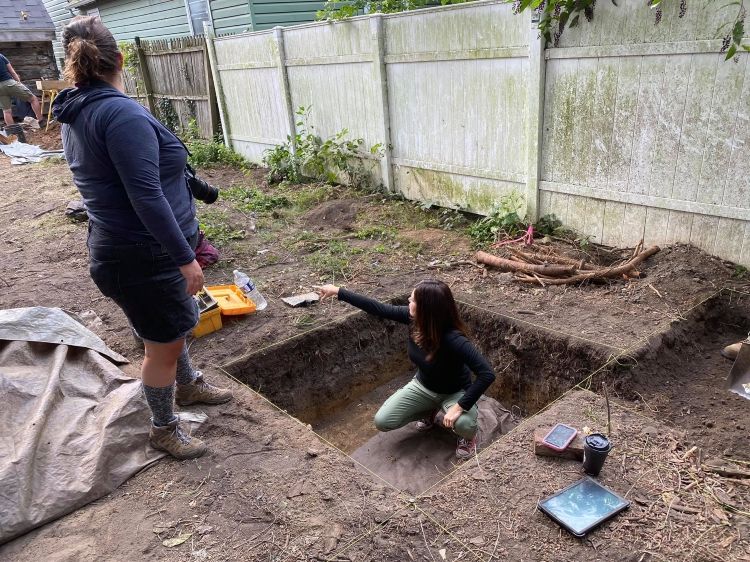Log Cabin Excavation Unearths Evidence of Forgotten Black Community
Artifacts recall a thriving Maryland neighborhood that was once a stop on the Underground Railroad
/https://tf-cmsv2-smithsonianmag-media.s3.amazonaws.com/filer/15/6d/156daeea-ec12-4638-b15a-b04e626b2fe9/cabin.jpg)
Slate pencils, pieces of dolls and other artifacts found beneath a 180-year-old cabin in Hagerstown, Maryland, speak to a largely overlooked chapter in local African American history.
As Brad Bell reports for WJLA, the house—excavated by archaeologists from the Maryland Department of Transportation State Highway Administration last month—stands in the center of what was once a thriving black community.
“It is long overdue that this lost and forgotten community rich history story is told,” Reggie Turner, a member of the Maryland Commission on African American History and Culture, tells WJLA. “The African American community here, their history is intertwined with the founder of Hagerstown and now it’s time to talk more about the contributions of this community.”
According to Julie Schablitsky, chief archaeologist at the highway administration, the cabin was built by German immigrants, probably in the 1830s. Preservation Maryland notes that the city’s founder, Jonathan Hager, may have owned the property at one time. It later became part of an African American commercial and cultural hub.
The small cabin at 417 Jonathan Street was largely overlooked until 2018, when a police patrolman crashed into it, reports Christina Tkacik for the Baltimore Sun. After the accident, authorities condemned the house, and its elderly owner moved out. A demolition crew subsequently realized that centuries-old logs bearing ax marks were hidden beneath the property’s vinyl siding.
Turner tells the Sun that Jonathan Street housed a community of free and enslaved black people as early as the 1790s. The neighborhood was a stop on the Underground Railroad, says Nicholas Redding, executive director of Preservation Maryland, but historians are unsure which buildings were actually involved in the anti-slavery network.
“It was a secret society,” Redding tells the Sun. “So people didn’t keep records.”

Research techniques used at the site included dendrochronology, or the study of tree ring growth to determine when logs were felled, as well as investigation of artifacts like toys, pipes and food remains. Archaeologists also found a pierced dime—a traditional African American good luck charm.
Today, Jonathan Street is one of the poorest areas in a city where the poverty rate stands at 27 percent. But local residents tell the Sun that they can remember a time in the 20th century when the area was full of locally owned businesses. Gracson Bell, 60, pointed out the former sites of a barbershop, a beauty parlor, a stable and a bowling alley built at a time when other bowling alleys in the state were only open to white patrons.
“Back then, the community had to rely on itself,” he says.
The Highway Administration notes that businesses in the area were listed in the Negro Motorist Green Book, which identified safe places for black travelers to stop in the segregated United States.
Richard Davis, the cabin’s former owner, sold it to Preservation Maryland for just $15,000, per the Sun. The organization now hopes to raise about $200,000 to restore the historic property. Staff plan on working with Habitat for Humanity to transform the 800-square-foot building into a home for a low-income person or couple.
In recent years, archaeologists with the state Highway Commission have increasingly focused on documenting the history of black communities and the Underground Railroad. In 2018, reports Reina Gattuso for Atlas Obscura, researchers excavated a cabin located on the property of the oldest home in Cambridge, Maryland. Their findings confirmed reports from local black oral histories that suggested the cabin once housed enslaved people.
Like the Hagerstown findings, discoveries at the Bayly House paint a picture of the daily lives of regular individuals. Schablitsky’s team found plates, buttons and doll parts, in addition to animal bones that testify to the culinary creativity of the cabin’s residents. These individuals’ diets mixed domesticated farm animals, fish and a wide variety of game.
Atlas Obscura notes that a 28-year-old woman named Lizzie Amby escaped from the Cambridge cabin in 1857, fleeing with her husband and 14 other people under Harriet Tubman’s guidance. The property’s owner, Alexander Hamilton Bayly, placed a notice in a local newspaper offering $300 for Amby’s return.
“That was a time when the Underground Railroad was on fire,” Schablitsky tells Atlas Obscura. “People were leaving Cambridge by the dozens.”
/https://tf-cmsv2-smithsonianmag-media.s3.amazonaws.com/accounts/headshot/Livia_lg_thumbnail.png)
/https://tf-cmsv2-smithsonianmag-media.s3.amazonaws.com/accounts/headshot/Livia_lg_thumbnail.png)